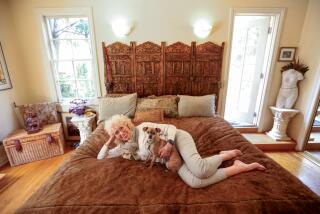HOME DESIGN : Bedrooms Have Become Lavish Islands in Swift Stream of Life
- Share via
Judy Deaton has never forgotten the sage words of her former interior design instructor: “When you go to visit a client’s house, always ask to see the bedroom. That will show his true personality.”
Rooms that will be seen by neighbors and friends may be decorated to impress other people, he said, but one decorates a bedroom only to please oneself.
“The bedroom says more about a person than anything else,” says Deaton, now an interior designer with the Interior Designers Institute in Corona del Mar.
Cheryl Bechtold, owner of The Bedspread Story in Anaheim, which offers custom bedspreads and all the trimmings, has theorized about who is attracted to different styles of beds.
“Those who choose contemporary tend to be more on the outgoing, younger side,” Bechtold says. “They’re more daring.”
Clients who want the “country, cutesy stuff,” meanwhile, tend to be more conservative and introverted, she says. They’re often homebodies.
“Victorian-style bedspreads usually appeal to an old-fashioned person. I made one for a woman was very quiet, very soft-spoken. The bedspread she wanted was a frilly satin chiffon. It fit.”
On occasion, Bechtold has been surprised by couples who appear conservative, yet pick the wildest bedspread.
“They don’t show that private side,” she says.
As the focal point of the room, beds can uncover a lot about their owners’ personalities, moods and hidden desires.
Deaton thinks it is no accident that today’s beds have become increasingly lavish--with elegant bed linens, frothy pillows, coordinating dust ruffles, upholstered headboards, canopies and tents.
“With the mood of our generation, there’s more emphasis on the bed,” she says. “I was talking with my designer friends about how everyone is more into themselves, and there’s a big promotion of intimacy.”
It is as if people have decided, “Nothing’s too good for myself, and therefore, my bed.”
Bedding stores offer ample opportunity for self-indulgence.
At Sheridan in South Coast Plaza in Costa Mesa, shoppers have their choice of fantasies. They can find coordinating sheets, pillowcases, comforters, dust ruffles and throw pillows to match any mood.
Feeling regal? One can outfit a wooden canopy bed in an Old World-style comforter with a navy paisley print, gold and navy foulard sheets and coordinating striped pillows in navy, gold and cranberry.
Feeling primitive? There’s a tropical comforter and coordinating sheets with palm leaves, parrots and cockatoos in bright greens, reds and yellows, reminiscent of a Gauguin painting.
Styles vary dramatically, from a slate blue, pink and cream floral print that is awash in ruffles to a simple black-and-white geometric print with hot pink accent pillows.
“People can express themselves with their bedding without worrying about what others think,” says Elaine Hankin, an interior designer in Huntington Beach. “They can reveal their hidden desires for wonderful fabrics and textures. In public spaces, they tend to be more conservative.”
Hankin has found her male clients generally favor geometric patterns and strong colors, avoiding pastel florals.
“They really like the black, white and red geometrics,” she says. “They want to be certain there’s nothing frilly about their beds. They want something totally different from what mom had.” Freud might have called it bedspread envy.
Women, however, often indulge in frilly, lacy spreads and pillows--the kind of bedding that makes them feel pampered.
Occasionally, Hankin has clients who break the stereotypes.
“I’ve had men want a princess bed. They have fantasies,” she says. “I had a very strait-laced client who asked for an antique sleigh bed, the kind with the headboard that curved outward, and magnificent, sensuous silks. I thought, ‘Wow, there’s some fire burning in there somewhere.’ ”
An older couple surprised her by requesting linens in black lace and silk.
“I was amazed. These were not young people, but they really wanted something unusual.”
When two people share a bed, their distinctive personalities can lead to a battle over bedding.
“With young married couples, there’s always a conflict,” says Walter Nutting, a Costa Mesa interior designer. “We get these guys who have to move out of their bachelor pads into Laura Ashley bedrooms. I stand back and let them work it out.”
Nutting also has been surprised by his clients’ choice of bedding. “I’ve run into very masculine men who have very frilly beds. I don’t know what that says.”
For some discriminating sleepers, even the standard rectangular mattress won’t do.
Newport Bedding, a manufacturer of custom mattresses in Costa Mesa, has handled orders for beds shaped into hearts and horseshoes, or perfect squares and circles. Some customers want bigger than king-sized beds.
“They just like all that romping room,” says store owner Tom Sceberras.
People have come to treat their bedrooms as a refuge from the outside world. Instead of venturing out into traffic jams, they stay at home and watch a movie on the VCR. Many have moved entire entertainment units into their bedrooms, turning the room into a separate apartment.
Consequently, “the bed itself has become more important,” Deaton says. “It’s larger in scale and more dramatic.”
People are investing in heavier headboards, from gleaming silver-plated rods to stripped logs. “In the mid-’80s, beds were lighter. We used a lot of plain Scandinavian platforms,” Deaton says. “Today we have upholstered headboards, more canopies and heavier wood.”
Even the placement of the bed in the room has changed to reflect its greater status. No longer is it automatically shoved against a wall.
“Now the bed is often set in the center of the room like a big, oversized couch,” Nutting says. “We never used to do that.”
Interior designers say their clients want to lavish money and attention on their beds because they are spending more time in their bedrooms. “Most people have such stressful work lives,” Deaton says, “that they have a need for a place that’s quiet and intimate.”


